Care and Maintenance of a Clarinet
Monthly care and maintenance
Inspecting the keys
Screws may naturally loosen on their own. Check the condition of the keys and tighten the screws if necessary.
Applying key oil
Apply a little key oil (M) to the moving parts of the key. Be careful not to put too much on.
After applying the oil, move the keys to work the oil in properly. Thoroughly wipe off any excess oil or any oil that has ended up on the body.
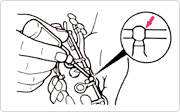
The function of the key oil is to protect the metal surfaces of the keys. When the key oil is applied, it spreads out to form a thin film on and between the metal. This oil film serves as a lubricant, enabling the metal components to move smoothly, without coming into direct contact with one other. Since the metal will not suffer wear if the friction is reduced, there will also be little abrasion. Yet another benefit of the oil is that since the oil film also protects the metal from moisture and air, it is able to protect it from rusting and corrosion. (Naturally, you should be careful not to apply too much oil.) If no key oil is applied, in the worst case the keys will get rusty and-although invisible-the microscopic rust particles will impair the action of the keys.

One problem that arises when no oil is applied is that the direct contact between the metal components when the keys are operated generates noise. The clattering when the instrument is played makes for an unpleasant sound and the clarinetist will be unable to concentrate on his playing. If the situation deteriorates further, the keys will become wobbly and it will become impossible to close the holes properly. Be careful to avoid this, as it would necessitate major repair work on the instrument. Be sure to apply key oil around once a month-or once every two weeks if you have sweaty palms.
Yamaha offers three types of key oil
The L (light) oil is for instruments such as the piccolo, flute, and oboe;
the M (medium) oil is for the clarinet;
and the H (heavy) oil is for instruments such as the saxophone, bass clarinet,
and bassoon.
Be careful to use the right type of oil for your instrument, as each type has a different viscosity.
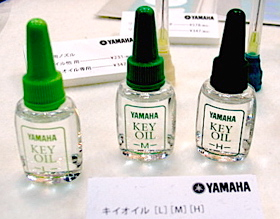
Cleaning the tone holes
Special tone hole cleaners are used for cleaning the tone holes. The tone hole cleaner has an inner core of wire and a soft, lacy outer surface. It can be twisted into shape, inserted through a tone hole, and used on the insides of the instrument.
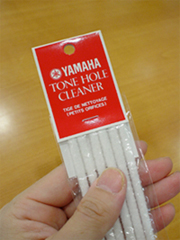
Tone hole cleaners
This is not the only way in which tone hole cleaners can be used. In the areas around the keys on the outside surface of a woodwind instrument there are many uneven sections featuring complex indentations, and tone hole cleaners perform sterling service removing the dust that accumulates in them. The use of the key oil makes the areas around the keys even more prone to dust, and if they go without being cleaned, the action of the keys will be affected and the feel of the instrument will change.
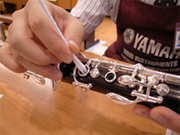
In the worst case extraneous matter will get in, it will become impossible to close the caps, and maintenance may be required. Make it a habit to remove dust whenever possible.
Be very careful not to damage the tone holes or any other parts of the instrument with the metallic tip of the tone hole cleaner.
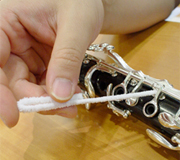
If color changes in the keys bother you
Yellowish discoloration of the keys and blackening of the joints occurs due to the silver component in the silver plating reacting with sulfur in the air. While this does not pose a problem, you can wipe it with a silver cloth if it bothers you.
Cleaning the register key hole
Use a tone hole cleaner to remove dirt from the register key hole as well.
Musical Instrument Guide:Clarinet Contents
Structure
How the Instrument is Made
Choosing an Instrument
Trivia
- "I Broke My Clarinet" is a French folk song
- Inspiring composers
- In Italy, a single B♭ clarinet
- At one time, most clarinets were made of boxwood
- In vogue in the 1900s-the metal clarinet
- A transparent clarinet?
- Famous clarinet works: concertos
- Famous clarinet works: chamber music
- What is the relationship between hertz and cents?
